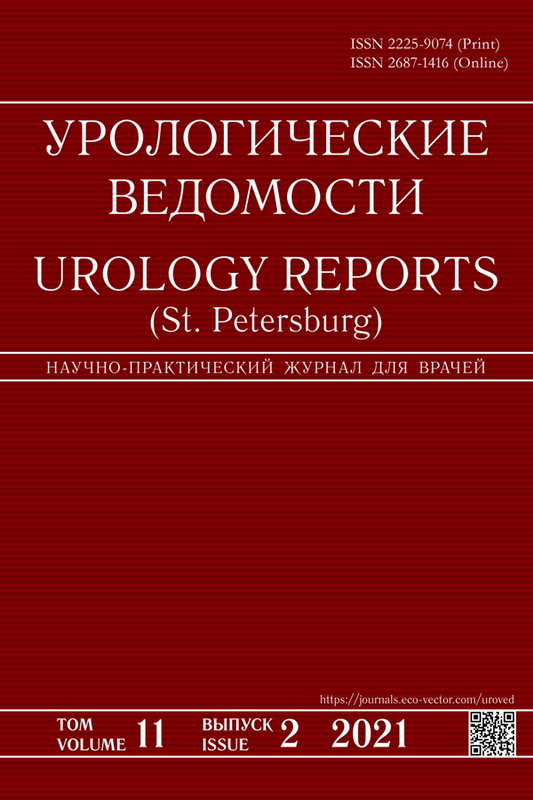Clinical and laboratory features of the course of obstructive pyelonephritis in a patient with quantitative kidney abnormality
- Authors: Suleymanov S.I.1,2, Kadyrov Z.A.1, Dilanyan O.E.2, Ramishvili V.S.1, Musohranov V.V.2, Babkin A.S.2
-
Affiliations:
- RUDN University
- The State Healthcare Institution No. 13
- Issue: Vol 11, No 2 (2021)
- Pages: 183-190
- Section: Сlinical observations
- URL: https://journals.eco-vector.com/uroved/article/view/70857
- DOI: https://doi.org/10.17816/uroved70857
- ID: 70857
Cite item
Abstract
The kidney duplication is the most common abnormality of the urinary system. In most cases, this condition is an accidental finding on prenatal ultrasound or can be diagnosed when the first clinical manifestations occur. Abnormalities of the upper urinary tract can be detected when examining a patient with arterial hypertension, proteinuria, or renal failure. As an example of the complicated course of the inflammatory process in a patient with quantitative kidney abnormality, a clinical observation of the course of obstructive pyelonephritis against the background of complete obliteration of the lower third of the ureter with the formation of terminal changes in the upper half of the doubled kidney, which led to renovascular hypertension and clinically significant renal failure, is presented. The article describes the clinical manifestations of the disease, laboratory and diagnostic screening, as well as the stages of surgical treatment in a multidisciplinary hospital.
Full Text
About the authors
Suleyman I. Suleymanov
RUDN University; The State Healthcare Institution No. 13
Author for correspondence.
Email: s.i.suleymanov@mail.ru
ORCID iD: 0000-0002-0461-9885
SPIN-code: 7168-8819
Scopus Author ID: 57080003900
Dr. Sci. (Med), Professor, Head of the Urological Unit
Russian Federation, 6, Miklukho-Maklaja str, Moscow, 117198; 1/1, Velozavodskaja str, Moscow, 115280Zieratsho A. Kadyrov
RUDN University
Email: Zieratsho@yandex.ru
ORCID iD: 0000-0002-1108-8138
SPIN-code: 6732-8490
Scopus Author ID: 6602093282
Dr. Sci. (Med), Professor
Russian Federation, 6, Miklukho-Maklaja str, Moscow, 117198Oganes E. Dilanyan
The State Healthcare Institution No. 13
Email: dilanyan@gmail.com
ORCID iD: 0000-0002-3447-9684
Cand. Sci. (Med), Urologist
Russian Federation, 1/1, Velozavodskaja str, Moscow, 115280Vladimir S. Ramishvili
RUDN University
Email: ramishvilivladimir60@gmail.com
ORCID iD: 0000-0001-9431-3478
SPIN-code: 7365-9769
Scopus Author ID: 15835683400
Dr. Sci. (Med), Professor
Russian Federation, 6, Miklukho-Maklaja str, Moscow, 117198Vladislav V. Musohranov
The State Healthcare Institution No. 13
Email: vlad412@mail.ru
ORCID iD: 0000-0003-1336-931X
Cand. Sci. (Med), Urologist
Russian Federation, 1/1, Velozavodskaja str, Moscow, 115280Alexander S. Babkin
The State Healthcare Institution No. 13
Email: alexbabkin3004@mail.ru
ORCID iD: 0000-0003-1570-1793
Urologist
Russian Federation, 1/1, Velozavodskaja str, Moscow, 115280References
- Komyakov BK. Urology. Moscow: GEOTAR-Media; 2018. 131 р. (In Russ.)
- Vasiliev AO, Govorov AV, Pushkar DYu. Embryological aspects of congenital anomalies of the kidney and urinary tract (cakut). Urology herald. 2015;(2):47–60. (In Russ.)
- Stonebrook Е, Hoff М, Spencer JD. Congenital Anomalies of the Kidney and Urinary Tract: A Clinical Review. Curr Treat Options Pediatr. 2019;5(3):223–235. doi: 10.1007/s40746-019-00166-3
- Ruano R, Dunn T, Braun MC, et al. Lower urinary tract obstruction: fetal intervention based on prenatal staging. Pediatr Nephrol. 2017;32(10):1871–1878. doi: 10.1007/s00467-017-3593-8
- Pavlova VS, Kryucko DS, Podurovskaya YuL, Pekareva NA. Congenital malformations of the kidneys and urinary tract: analysis of modern principles of diagnosis and prognostically significant markers of kidney tissue damage. Neonatology: News, Opinions, Training. 2018;6(2):78–86. (In Russ.) doi: 10.24411/2308-2402-2018-00020
- Goncharov SS, Klimenko ES. Anomalii razvitiya pochek: udvoyeniye pochki. Abstracts Nationwide scientific forum of students with international participation “Student Science – 2019”. FORCIPE. 2019;2(S):192–193. (In Russ.) Available https://cyberleninka.ru/article/n/anomalii-razvitiya-pochek-udvoenie-pochki/viewer
- Nechiporenko AN, Nechiporenko NA, Yutsevich GV, et al. Surgical correction of urodynamic disorders in one of the doubled kidney segments. Surgery. Eastern Europe. 2021;10(1):78–79. (In Russ.) doi: 10.34883/PI.2021.10.1.016
- Raja J, Mohareb AM, Bilori B. Recurrent urinary tract infections in an adult with a duplicated renal collecting system. Radiol Case Rep. 2016;11(4):328–331. doi: 10.1016/j.radcr.2016.08.015
- Degtyar VA, Hharitonuk LN, Bojko MV, et al. Тhe ways of recovery of morphofunctional state of duplicated kidneys. Child’s health. 2019;14(8):480–484. (In Ukr.) doi: 10.22141/2224-0551.14.8.2019.190842
- Ramanathan S, Kumar D, Khanna M, et al. Multi-modality imaging review of congenital abnormalities of kidney and upper urinary tract. World J Radiol. 2016;8(2):132–141. doi: 10.4329/wjr.v8.i2.132
- Sokolov AA, Zinukhov AF, Pokrovskiy KA, et al. Laparoscopic resection of the right kidney upper segment with ureterectomy for full duplex kidney. Annaly khirurgii (Russian Journal of Surgery). 2017;22(4): 241–246. (In Russ.) doi: 10.18821/1560-9502-2017-22-4-241-246
- Herrmann SM, Textor SC. Current Concepts in the Treatment of Renovascular Hypertension. Am J Hypertens. 2018;31(2):139–149. doi: 10.1093/ajh/hpx154
- Singh M, Agarwal S, Goel A, et al. Laparoscopic transperitoneal heminephrectomy for treatment of the nonfunctioning moiety of duplex kidney in adults: A case series. Investig Clin Urol. 2019;60(3):210–215. doi: 10.4111/icu.2019.60.3.210.
Supplementary files












